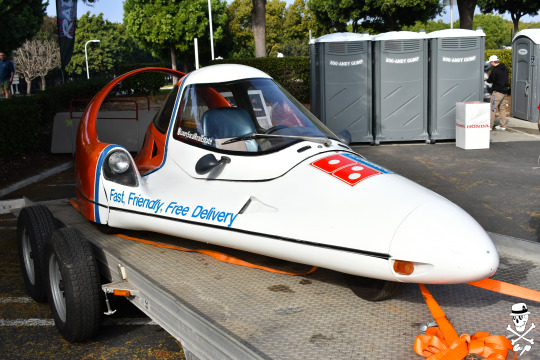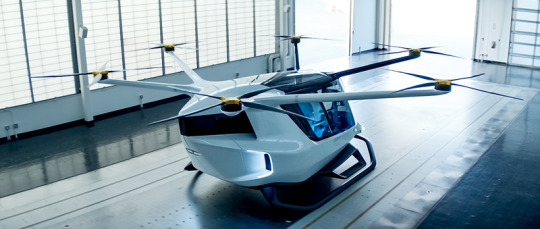#aerocar
Text

Oh Aerocar of the 1949s ily so much, such a silly creature they were. 💕 I might have had too much fun watercoloring this fella. :'3
Brief history on this little critter + bit of a geekout on aircraft design under the cut ~🛩
I always find those articles that claim these random millionaires are supposedly "making the 1st flying car" and they end up showing off either yet another quadcopter or some other VTOL monstrosity with 10000 little motors on it. (Who is designing those ugly things for real?! I love weird experimental aircraft, but they still have to follow the #1 law of flight: aircraft only fly as good as they look) Meanwhile this cute little fella's been around since 1949. At the time it was both street legal and had a Civil Aeronautics Association (pre FAA) airworthiness certification! That's right, this was a certified airplane that was also a car! :D It could drive about 60 MPH on the road and flew about 120 MPH in cruise-which is about the same as the average Cessna 172 on a good day. 😆
It actually entered production and about 8 were made, but despite the fact there was a market for it at the time and many people did place orders for them, the designer, Moulton Taylor, just never made any more than that because they turned out to be too complex and expensive to build. Tho he did design and build other varients and made plans to build em available (and some people have built flying versions from plans) the concept just didn't exactly takeoff among homebuilders.
Don't blame em personally, I'm not too big on the idea of flying planes that utilize driveshafts for their propellers. Too much room for error when you add more moving parts to an aircraft. (helicopters dni) Still cute little aircraft tho, their shape, history, and design sure is neat! And there's one that still takes to the skies regularly! I'd love to meet the pilot one day and ask how it handles :]
Maybe the design could be revisited in the future? Maybe replace the O-320 Lycoming with one of those microjets? Maybe make the fuselage from composites? :o
#planeposting#planes#aviation#avgeek#aviation history#experimental aircraft#aerocar#flying car#aviation art#my doodles
19 notes
·
View notes
Photo

Taylor Aerocar. 1954
22 notes
·
View notes
Text

What never was in 1971
2 notes
·
View notes
Text

1953 Aerocar Cordoba prototype
15 notes
·
View notes
Photo

1984 Tritan A2 Domino's Pizza Delivery Car
Radwood SoCal 2021
What could have been the future of pizza delivery
#Tritan#TritanA2#Aerocars#Dominos#Pizza#1980s cars#transportation#automobile#auto#automation#car photography#Radwood#radwood SoCal 2021#Rocket cars
0 notes
Note
Are there any famous Basque inventors?
Kaixo, anon!
They're not famous, but their inventions are almost everywhere:
the articulated trains, by Alejandro Goicoechea

this kind of staplers (by company El Casco)

this bottle-opener (by David Olañeta)

the so-called Spanish aerocar (by Basque-Cantabrian Torres-Quevedo, who was actually a genius, check him out)

the cacolet, or riding saddle for two. It's traditional of the Basque pyrenees.

the bayonet. It was invented by Bayonais soldiers in the 17th century, after a shortage of ammunition.

81 notes
·
View notes
Text
El sueño de volar
Los sueños de volar algún día se harán realidad con los vehículos aéreos eléctricos de pasajeros. Desde Ícaro desafiando al sol con alas de cera hasta los Wright elevándose sobre Kitty Hawk, la humanidad ha estado obsesionada con surcar los cielos. Ahora, disruptivas startups prometen llevar esa fantasía a nuestras ciudades con taxis aéreos autónomos. Pero mientras visionarios como Lilium y Joby Aviation buscan que despeguemos hacia los suburbios, los autos eléctricos terrestres como los de Tesla ya recorren velozmente las carreteras. ¿Podrán los vehículos voladores personales sortear obstáculos regulatorios y de infraestructura para materializar su potencial? ¿O el futuro de la movilidad eléctrica seguirá atado al asfalto? Revisemos el panorama.

Los humanos han soñado con volar desde la antigüedad. Los primeros esfuerzos se centraron en emular el vuelo de las aves con alas artificiales. En el siglo IX, Abbas Ibn Firnas construyó unas alas rudimentarias y se lanzó desde una torre, planeando brevemente. En el Renacimiento, Leonardo Da Vinci diseñó varios prototipos de máquinas voladoras. Pero no fue hasta finales del siglo XVIII que los hermanos Montgolfier inventaron el globo aerostático, demostrando por primera vez que el vuelo era posible.
A mediados del siglo XIX, Sir George Cayley sentó las bases de la aerodinámica moderna al identificar las cuatro fuerzas que actúan sobre un avión. A principios del siglo 20, los inventores comenzaron a experimentar con autos voladores y aeronaves híbridas tierra-aire.
En 1903, los hermanos Wright lograron el primer vuelo propulsado y controlado en un avión más pesado que el aire. La Primera Guerra Mundial vio grandes avances en el diseño de aviones. En 1917, Glenn Curtiss desarrolló el Autoplane, considerado uno de los primeros diseños viables de un auto volador. En 1927, Charles Lindbergh cruzó el Atlántico en un vuelo transoceánico sin escalas.
En la década de 1930, Waldo Waterman creó varios prototipos exitosos de autos voladores que realizaron breves vuelos. Después, la Segunda Guerra Mundial trajo aviones a reacción y cohetes. Sin embargo, la tecnología y los materiales de la época limitaron el desarrollo en gran escala. La Segunda Guerra Mundial y la Guerra Fría desviaron los recursos e intereses hacia jets de combate y cohetes. No fue hasta la década de 1950 que nuevos intentos como el ConvAirCar Model 118 y el Aerocar Aero-Plane tuvieron algo de éxito, aunque eran complejos de operar. En 1969 el Apolo 11 aterrizó en la luna.
En la década de 1980, la Administración Federal de Aviación de EE. UU. estableció estándares de seguridad para vehículos de despegue y aterrizaje vertical. Esto renovó el interés y allanó el camino para desarrollos posteriores. Modelos notables de fines del siglo XX fueron el Avcen Jet Flying Car y el Moller Skycar M400. Sin embargo, los altos costos, la compleja logística y las limitaciones persistentes de almacenamiento de energía evitaron una adopción generalizada.

Ahora en las dos primeras décadas del siglo 21 hemos visto grandes avances en vehículos aéreos eléctricos para transporte urbano y regional. Compañías como Lilium, Joby Aviation y Archer Aviation están desarrollando taxis aéreos y vehículos de despegue y aterrizaje vertical eléctricos (eVTOLs) para viajes punto a punto más rápidos y sostenibles.
En 2006, el avión transitable PAL-V Liberty obtuvo la certificación de la Unión Europea para operar tanto en carreteras como en cielos. Otros como Terrafugia Transition están siguiendo un enfoque híbrido terra-aire. Mientras tanto, AeroMobil ha presentado prototipos de automóviles voladores de alta velocidad para 4 pasajeros.
China ha establecido una hoja de ruta ambiciosa para tener vehículos aéreos operativos masivamente en 2025. Compañías respaldadas como EHang ya tienen taxis aéreos autónomos funcionando en pruebas. Por otro lado, AirBus, Hyundai y Uber planean lanzar servicios aéreos urbanos en la próxima década. Con la electrificación, la autonomía y las asociaciones intersectoriales, es probable que veamos los vehículos voladores tripulados convertirse en una realidad común en los próximos años.
La compañía alemana Volocopter tiene el volador eléctrico Volocity, diseñado para trasladar 2 pasajeros sobre el entorno urbano sin necesidad de infraestructura adicional. Lilium, también alemana, trabaja en una aeronave eléctrica de despegue y aterrizaje vertical capaz de transportar a 4 pasajeros. En Estados Unidos, Joby Aviation construye el taxi aéreo eléctrico S4 con 4 plazas, ideal para entornos suburbanos.

Skai Alaka'i Technologies Hopkinton, Massachusetts, USA. www.skai.co
Se pronostica que este nicho alcanzará 580 mil vehículos anuales en 2040. Empresas como Alaka'i y JetPack Aviation desarrollan prototipos de jets personales compactos impulsados por hidrógeno. La visión futura es que estos vehículos puedan estar al alcance de cualquier persona interesada en experiencias de vuelo personalizadas e innovadoras.
A pesar del entusiasmo por los vehículos aéreos eléctricos de pasajeros, su adopción masiva enfrenta desafíos. Los autos eléctricos terrestres ya tienen una infraestructura establecida de carriles, estaciones de carga y cadenas de suministro. La movilidad aérea urbana, por otro lado, debe resolver complejos rompecabezas regulatorios, de espacio aéreo, ruido y seguridad antes de materializarse.
El futuro de la movilidad aérea personalizada está despegando. Con innovadores vehículos eléctricos de despegue y aterrizaje vertical que transportan de 1 a 4 pasajeros, empresas visionarias lideran una revolución silenciosa y sostenible. Libres como pájaros, pronto cruzaremos ciudades abarrotadas pilotando nuestros propios taxis aéreos. El cielo es el límite para esta nueva era dorada de aviación personal.
¡Agárrate!
Gracias por leerme y compartir
@ptorresmx

2 notes
·
View notes
Text




today I found out about the Tritan A-2 "Aerocar," an experimental type of microcar that's a unique and cool little footnote in aerodynamic/automotive history but only 10 were ever made, all for Domino's pizza to test out as a new delivery vehicle. So now all the photos of them are in like cool and exotic and interesting places, but it's always advertising pizza.
3 notes
·
View notes
Photo

1932 Graham Blue Streak Coupe, 4litre 8cylinders 90hp 137kmh & Curtiss Aerocar Land Yacht. A rather unusual vehicle for daily use, but not to the American banker Hugh McDonald who used this luxurious combination in the early 1930s to be driven from his estate on Long Island to his office in New York. The semi-trailer resembles an aeroplane and was built in accordance with aviation construction principles by the Curtiss Aeroplane Company in Florida. A lightweight, tubular metal frame is braced with wire cables. The Aerocar’s nose looks like a cockpit and is fitted with a compass, barometer, altimeter, speedometer and swivelling floodlights. The interior is furnished with lightweight wicker chairs and a desk. The galley features a refrigerator and there is also a lavatory with flushing toilet. The yacht was towed by a Graham Blue Streak fitted with a four-litre engine. A spare wheel was placed in the space normally occupied by the ‘dickey seat’. The towing pin of the trailer fits in a socket in the hub and the tyre damped out the shocks while driving. Source: louwmanmuseum.nl #throwback #workingtruck #workingtrucks #history #vintage #missthosedays #13yearsago #rustytruck #rustytrucks #throwbackpic #yearago #thosewerethedays #throwbackthursday #ayearago #throwback🔙 #cdljob #cdljobs #cdlhunter (at CDL Hunter) https://www.instagram.com/p/CjWY2gfpS0-/?igshid=NGJjMDIxMWI=
#throwback#workingtruck#workingtrucks#history#vintage#missthosedays#13yearsago#rustytruck#rustytrucks#throwbackpic#yearago#thosewerethedays#throwbackthursday#ayearago#throwback🔙#cdljob#cdljobs#cdlhunter
6 notes
·
View notes
Text

inking a lil aerocar :3
one of the few little planes I don’t think I’d like to fly, but I love the shapes and silly idea. It’s not that the concept of an adorable flying car built and designed from the 1940s thru the 60s, but I’m a little iffy about planes that utilize a driveshaft to spin their propellers at a considerable distance. The engine for this would have been mounted on the rear of the cabin, about the same as a VW Beetle, and the propeller is allllll the way at the very end of the tail (not drawn yet lol- I sketch those in with a compass after colors.).
I always laugh at any new articles sponsored by super rich start up guys claiming to have built the first flying cars when these little guys have been around for decades. (no shade to Terrifugia tho, I have a soft spot for them cause they’re adorable little guys that look like Winguls and they’re nostalgic to me. I’ll never forget meeting one of the prototypes when I was like 11 :’3). Sadly not many of them were made as the FAA had come into play about the time these guys were really starting to take off and strict new regulations at the time killed em. :c
1 note
·
View note
Text
"cars" was translated into russian as "тачки" which is a cooler and less generic word for cars and "planes" is just planes because there's no other word for planes. however "sky force," a knock off of planes, was translated as "aerocars" to trick you into thinking it has anything to do with cars, and on russian wikipedia it's wrongly listed as being in the same series and i think nobody noticed because nobody cares about or remembers planes
1 note
·
View note
Photo

¿Qué pasó con Aerocar Internacional? Con un pr... https://ujjina.com/que-paso-con-aerocar-internacional/?feed_id=582857&_unique_id=660f80147f977
0 notes
Text
AeroCare India: Leading Air Ambulance Services in Vellore
In the vast landscape of India, where access to advanced medical care can be challenging, air ambulance services play a crucial role in bridging the gap between patients and specialized healthcare facilities. Among the many cities in India benefiting from such services, Vellore stands out as a hub of medical excellence, with leading hospitals and research institutions attracting patients from across the country and beyond. In this article, we delve into the realm of air ambulance services in Vellore, highlighting their significance, key players, and the unparalleled assistance they provide in times of medical emergencies.
Air Ambulance Services in Vellore
Vellore, a city in Tamil Nadu, is renowned for its world-class medical infrastructure, including prestigious institutions like Christian Medical College (CMC) and hospitals equipped with state-of-the-art facilities. Despite these advancements, there are instances where patients require urgent transfer to specialized centers or need to be airlifted for critical care. This is where air ambulance services play a vital role, offering rapid and efficient transportation, often proving to be life-saving.
Significance of Air Ambulance Services
The significance of air ambulance services in Vellore cannot be overstated. In emergency medical situations, every minute counts, and the ability to swiftly transport patients to appropriate medical facilities can significantly enhance their chances of survival and recovery. Air ambulances are equipped with advanced medical equipment and staffed by highly trained medical professionals, ensuring that patients receive optimal care during transit.
Moreover, Vellore's geographical location further emphasizes the importance of air ambulance services. While the city boasts excellent medical facilities, reaching remote or inaccessible areas within Tamil Nadu or neighboring states can be challenging by road. Air ambulances circumvent these logistical challenges, offering a direct and expedited means of transportation, particularly in cases where time is of the essence.
Key Players in Air Ambulance Services
Several prominent organizations provide air ambulance services in Vellore, catering to the diverse medical needs of patients. These include both public and private entities, each contributing to the seamless operation of emergency medical transport. Among the notable players is the Government of Tamil Nadu's Health Department, which operates air ambulances to facilitate the transfer of critically ill patients to tertiary care centers.
Additionally, private air ambulance operators like Apollo Hospitals and GVK EMRI (Emergency Management and Research Institute) play a significant role in augmenting emergency medical services in Vellore. These organizations deploy dedicated air ambulances equipped with advanced medical equipment and staffed by skilled healthcare professionals, ensuring comprehensive care during transit.
Unparalleled Assistance in Medical Emergencies
The unparalleled assistance provided by air ambulance services in Vellore becomes evident in various medical emergencies, ranging from trauma cases to organ transplant transports. In critical situations such as accidents or natural disasters, where immediate medical intervention is imperative, air ambulances serve as a lifeline, swiftly evacuating patients to tertiary care centers equipped to handle complex medical conditions.
Moreover, air ambulances facilitate the transfer of patients requiring specialized treatments, such as cardiac surgeries or neurosurgical interventions, from Vellore to major metropolitan cities like Chennai or Bengaluru, where advanced medical expertise is readily available. This seamless connectivity ensures that patients receive timely and appropriate care, irrespective of their geographical location within the region.
Conclusion
In conclusion, air ambulance services in Vellore play a pivotal role in the healthcare ecosystem, providing critical support in times of medical emergencies. With their ability to swiftly transport patients, overcoming geographical barriers and logistical challenges, air ambulances ensure that individuals receive prompt and specialized medical care when it matters most. As Vellore continues to emerge as a center of medical excellence, the importance of air ambulance services cannot be overstated, reaffirming their status as indispensable assets in the realm of emergency medical transport.
#airambulance#airambulanceindia#airambulanceservices#costofairambulance#Air Ambulance Services in Vellore
0 notes


